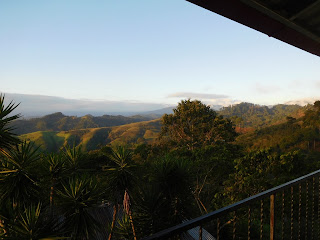COFFEE
We are in the midst of the coffee harvest. In the early
morning and late in the afternoon, you’ve got to be careful driving. In the
morning and the afternoon there are pickups and large trucks loaded with
workers – from grandmothers to little kids – going out to harvest coffee. In
the afternoon, crazy drivers with pickups full of bags of harvested coffee ply
the roads, going slowly up hills and quickly around curves.
The coffee harvest, mostly from November to February, is one
of the few times in the year when people of all ages can earn hard cash. Some
will find work in the off-season in construction or work on the coffee
plantations – pruning, fertilizing, and spraying for insects and plant
diseases.
People are paid by the gallon, which is actually a five-gallon
pail. Most growers pay 30 lempiras per galon, which is actually about
$1.25. Most people harvest about five per day, but I’ve known of some young
guys who can harvest ten or more.
The parish has two manzanas of coffee which is about 3.44
acres. In the last two weeks we’ve had three crews harvesting coffee. My guess
is that we’ve harvested more than two thousand galones. I don’t know how
that ends up in terms of grains of coffee, but it’s a lot.
I way “we” because I’ve been out harvesting two days and
helped all three days on transporting the workers to and from the site and
hauling the coffee to the place where the pulp is removed.
All of those who came are volunteers from the parish. They
get lunch but are not paid. It is great to see young and old – and middle-aged
– all helping the parish, since the proceeds will go to the parish budget.
Here are some more photos.
 |
| Moving coffee in berries from the truck to the depulper |
CLERGY
As a deacon, I am a member of the clergy and so had to go to
the clergy meeting in Santa Rosa de Copán on January 9 and 10 and as a
representative to the diocesan Social Ministry Council I had to go to a meeting
in Siguatepeque on January 16. As I grow older I find formal meetings less
helpful, especially when they involve more than seven hours of driving (as did
the trip to Siguatepeque). So it goes.
But I took advantage of the trip to Siguatepeque to go to a
store run by the local Mennonites where they sell homemade cheese, yogurt,
ice-cream, granola, bread, cookies, and more. I made sure that I had an
ice-chest with me to bring back cheese and yogurt!
But a real delight was seeing a stupendous sunset. I left
Siguatepeque about 4:00 pm. As I passed by Yaramanguila, Intibucá, I noted a
beautiful sunset about 5:20 pm, I noted a beautiful sky to my left. I stopped
to take a photo. All of a sudden a car stopped beside me, some friends from
Santa Rosa.
I proceeded on going up one side of a mountain and down
another. The sky kept changing, becoming more and more brilliant – with reds,
oranges, yellows mingling with the blue, gray, and white of the clouds and the
sky. It was incredibly beautiful – and helped me endure the long ride.
I took several pictures but there were pink highlights until
the sun disappeared completely behind the mountains.
YOUTH
I already wrote about the retreat workshop we had for
leaders of youth in five villages. I’m hoping to contact all the leaders so
that we can have a meeting at the end of this month to plan a parish-wide youth
encounter on Sunday, February 12.
I also hope to be able to visit each group in the next six
weeks or so. One problem is that most have their meetings on Sundays at 5 pm. I
have not yet learned to bi-locate!
WHAT ELSE?
Since the beginning of January, I’ve preached a good number
of times, I served as deacon at the deanery’s celebration of the World Day of
Prayer for Peace on January 7, I’ve baptized a number of young people, and
today I have two Celebrations of the Word with Communion – one for the ninth
day after a death in one village, the other for the anniversary of a death a
year ago.
 |
| Epiphany morning we celebrated in La Colonia San José Obrero |
Beside that I spoke with the university students from Briar Cliff
University who were in Gracias to help with building the parish retreat center
there.
This Saturday the diocese will end the celebration of its
100 years as a diocese.
Today I had time to check out the scholarship applications
to see if we had enough money. St. Thomas has been providing scholarships for students
enrolled in the alternative program for middle school and high school, Maestro
en Casa. The students study at home with books and radio programs and then
meet with teachers on the weekend.
And I’ve also had time to do some reading, finishing Daniel Berrigan's
Life is good. God blesses us - and provides, day after day, beautiful views of a beautiful country.













No comments:
Post a Comment